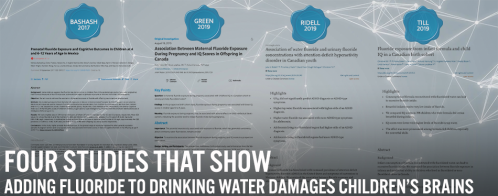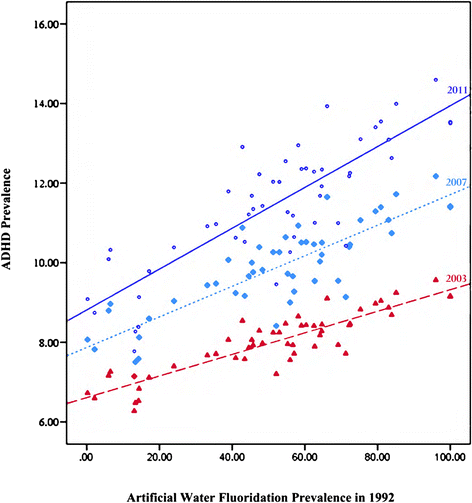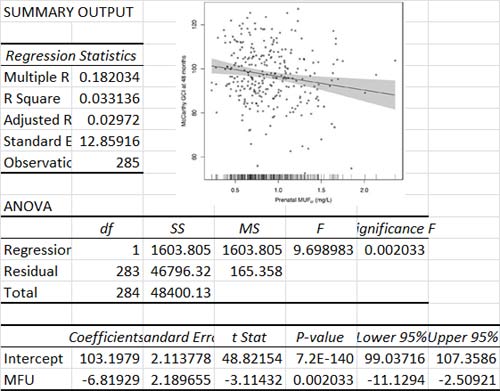A Fluoride Action Network (FAN) propaganda video where Paul Connett urges listeners to consider only four studies when considering the possible harmful effects of fluoridation.
Paul Connett, director of the Fluoride Action Network (FAN), now claims “You only have to read four studies…” to come to the conclusion that community water fluoridation (CWF) is bad for your health. He wants you to ignore all the other research – which is just bad science.
But this is even worse than it looks because these four studies are hardly independent. They basically represent the work of one or two groups and weaknesses in the studies indicate the groups are basically “torturing” data to produce relationships which confirm their likely biases against CWF. The same researchers appear as authors on most of the published papers from these studies.
But that is not all. There is evidence of an “old boy/girl network” operating within these research groups where journal peer reviewers are selected from the same groups.
It’s called “taking in each other’s laundry.”
For earlier articles in this series see:
- Part 1: Anti-fluoridation propaganda now relies on only four studies. 1: Bashash et al (2018).
- Part 2: Anti-fluoridation propaganda now relies on only four studies. 2: Green et al (2019).
- Part 3: Anti-fluoridation propaganda now relies on only four studies. 3: Riddell et al (2019)
- Part 4: Anti-fluoridation propaganda now relies on only four studies. 4: Till et al (2020).
- Part 5: Anti-fluoridation propaganda now relies on only four studies. 5: Don’t censor yourself.
In this article, I discuss the incestuous relationship of the studies promoted by Connett and show these researchers have links to anti-fluoride activism.
Links between the four studies
One indication of the lack of independence of these studies is the fact that the papers have common authors. The figure below reveals these links between the studies via their authors with the names in red being authors on more than one of the papers.
The above diagram indicates the four studies came from no more than 2 groups.
Martinez-Meir is common to both groups – probably because her laboratory was responsible for the analysis of maternal urinary fluoride.
Christine Till has been responsible for several of these studies as she obtained funding on the back of the flawed Malin & Till (2015) study (see Leader of flawed fluoridation study gets money for another go).
Till and Lanphear appear to have responsibility for formulating and designing these studies.
So it is wrong to see these as completely independent studies. They will all be influenced by the biases of the groups involved and the links shown in the figure above suggest coordination in publishing their research findings.
This becomes more apparent when we look at the journals involved in publishing some of this work and the peer reviewers used.
Links with peer reviewers
Unfortunately, very few journals make available the names of peer reviewers or the contents of their reviews. A pity, as I would like to understand better the controversy that seemed to erupt during the journal review of the Green et al (2019) paper, for example. (This controversy resulted in an unprecedented brief statement from the Editor and an opinion piece by David Bellinger promoting the paper – see If at first you don’t succeed . . . statistical manipulation might help).
However, some of the researchers have published their fluoride work in the journal Environmental Health which in recent years has published peer reviewer names and the contents of their reviews. So let’s look at papers published by the authors Connett is promoting where this peer review information is available. They were all published in Environmental Health and are:
- Malin, A. J., & Till, C. (2015). Exposure to fluoridated water and attention deficit hyperactivity disorder prevalence among children and adolescents in the United States: an ecological association. Environmental Health, 14(1), 17.
- Liu, Y., Téllez-Rojo, M., Hu, H., Sánchez, B. N., Martinez-Mier, E. A., Basu, N., … Peterson, K. E. (2019). Fluoride exposure and pubertal development in children living in Mexico City. Environmental Health: 18(1), 1–8.
- Grandjean, P. (2019). Developmental fluoride neurotoxicity: an updated review. Environmental Health, 1–17.
- Malin, A. J., Bose, S., Busgang, S. A., Gennings, C., Thorpy, M., Wright, R. O., … Arora, M. (2019). Fluoride exposure and sleep patterns among older adolescents in the United States: a cross-sectional study of NHANES 2015 – 2016. Environmental Health, 1–9.
- Uyghurturk, D. A., Goin, D. E., Martinez-mier, E. A., Woodruff, T. J., & Denbesten, P. K. (2020). Maternal and fetal exposures to fluoride during mid-gestation among pregnant women in northern California. Environmental Health, 2, 1–9.
This diagram illustrates some of the papers and the reviewers and links the authors and reviewers.
Note: The extra papers considered in the figure are:
- Choi, A. L., Sun, G., Zhang, Y., & Grandjean, P. (2012). Developmental Fluoride Neurotoxicity: A Systematic Review and Meta-Analysis. Environmental Health Perspectives, 1362(10), 1362–1368.
- Bashash, M., Thomas, D., Hu, H., Martinez-mier, E. A., Sanchez, B. N., Basu, N., … Hernández-avila, M. (2018a). Prenatal Fluoride Exposure and Cognitive Outcomes in Children at 4 and 6 – 12 Years of Age in Mexico. Environmental Health Perspectives, 125(9).
- Bashash, M., Marchand, M., Hu, H., Till, C., Martinez-Mier, E. A., Sanchez, B. N., … Téllez-Rojo, M. M. (2018b). Prenatal fluoride exposure and attention deficit hyperactivity disorder (ADHD) symptoms in children at 6–12 years of age in Mexico City. Environment International, 121(August), 658–666.
- Grandjean, P. (2019). Developmental fluoride neurotoxicity: an updated review. Environmental Health, 1–17.
Yes, it’s a real network and perhaps it’s not necessary to follow the details of each link. We can see, though, that authors on these papers often appear as journal peer reviewers of other papers from these research groups.
I suspect this situation may be more common in science publishing than we realise – especially as journals now often ask authors to suggest possible reviewers and to specifically name researchers they do not want to review their work.
I think that is bad for the quality of published research. It’s easy to see that in a network like this peer review is done within the groupthink (or bias) that exists in such a network. I raised this problem when commenting on the peer review of an earlier paper from the network – Malin & Till (2015) – in my articles Poor peer-review – a case study and Poor peer review – and its consequences. In this case, the reviewers were fixated on chemical toxicity as the reason for health problems so did not consider all the other possible factors that might be responsible for the prevalence of ADHD diagnoses. They, therefore, missed completely possible regional effects which were at the time shown as important (see Perrott 2018).
This author/peer-reviewer network is particularly bad in situations like this where a controversial or even flawed paper gets approval simply because of the common biases of authors and peer reviewers.
Links with anti-fluoride campaigners
Notice in the figure above that two of the reviewers for Grandjean’s paper are members of FAN – senior members at that. While their contribution to improving the paper was probably minimal (Spittle’s comment – “The review capably considers recently available information and is highly pertinent to the public health” was worthless) the fact these reviewers were selected by the journal (and possibly by the author who is also the Chief Editor of the journal) indicates some influence.
These links indicate some sort of “under the table” influence and linking of researcher with FAN which probably explains why FAN often seems to have early information about upcoming publications which enable them to launch timely propaganda pieces.
Journals used for publication
Environmental Health is open access and a pay-to-publish journal. Pay-to-publish is becoming more common but many researchers steer away from these journals because they tend to have a reputation that payment encourages publication of bad research. On the positive side (as I said above) the open access policy, in this case, helps us see when the peer reviewers are and understand the problems I have discussed.
A relevant aspect of the author-peer-reviewer network, in this case, is the involvement of journal editors in the network as shown by this diagram.
NOTE: See notes for previous figure.
Phillipe Grandjean is also the author of Grandjean et al (2019) which appeared in the previous figure. I have written about his specific biases regarding fluoride in the past (see Special pleading by Philippe Grandjean on fluoride) and it is notable that as Editor in Chief of Environmental Health he refused to even consider for publication my paper critiquing Malin & Till (2015) (see Fluoridation not associated with ADHD – a myth put to rest).
David Bellinger is linked to the Bashash et al (2018a) study, not as an author, but as the note in the paper says:
“David Bellinger collaborated on the design and execution of this study’s cognitive testing.”
So it’s not surprising to see him authoring a promotion of the Green et al (2019) paper – although the inclusion of that promotion and the special note from the journal’s editor in that issue of the journal is very unusual.
Conclusions
The lack of independence in these four studies really reinforces the danger of limiting one’s reading. It’s not just a matter of restricting reading to four papers – its a matter of restricting information sources to one (or perhaps two) research groups influenced by the same groupthink and biases.
Group thinking and bias within research groups are not new. Nor is it a surprise that journals can be influenced by such group thought and bias and that this influences their acceptance of papers for publication. But if you are aware of the problem then you realise the need not to restrict your reading in the way that Connett is suggesting.
If anything, Connett’s statement is an admission that the overall findings of scientific studies on this issue do not support his case. He admits that all the studies anti-fluoride activists had been relying on in the past suffer from relating only to high fluoride concentrations. His plea people now restrict their reading to only four studies which really limits information sources to one or perhaps two research groups with a bias against CWF, is aimed at censoring the wider information availble.
Even more reason for readers to beware. One should never restrict information sources in the way Connett is suggesting.
See also:
- Poor peer review – and its consequences
- Poor peer-review – a case study
- Fluoridation not associated with ADHD – a myth put to rest
- Some fluoride-IQ researchers seem to be taking in each other’s laundry


































